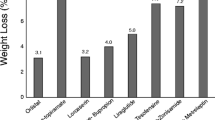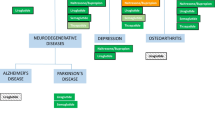Abstract
Overweight and obesity have been rising dramatically worldwide and are an independent risk factor for cardiovascular disease (CVD). The majority of overweight and obese patients who achieve a significant short-term weight loss fail to maintain their lower weight in the long term. As a result, there has been focus on the role of pharmacotherapy for long-term weight management. Since the beginning, the quest for weight loss drugs has encountered warnings from regulatory agencies and withdrawals from the market. Accordingly, fenfluramine, dexfenfluramine, rimonabant, and sibutramine have been withdrawn from the market due to unacceptable side effects. Nevertheless, there is still intense research for the development of new anti-obesity compounds. The effect of these molecules on CVD risk factors has been reported, but one must remember that beyond CVD risk factor management, anti-obesity drugs should be safe for the long term.
Similar content being viewed by others
References
Papers of particular interest, published recently, have been highlighted as: • Of importance •• Of major importance
Poirier P, Giles TD, Bray GA, Hong Y, Stern JS, Pi-Sunyer FX et al. Obesity and cardiovascular disease: pathophysiology, evaluation, and effect of weight loss: an update of the 1997 American Heart Association Scientific Statement on Obesity and Heart Disease from the Obesity Committee of the Council on Nutrition, Physical Activity, and Metabolism. Circulation 2006; 113(6):898–918.
Executive summary of the clinical guidelines on the identification, evaluation, and treatment of overweight and obesity in adults. Arch Intern Med 1998; 158(17):1855–1867.
Drolet B, Simard C, Poirier P. Impact of weight-loss medications on the cardiovascular system: focus on current and future anti-obesity drugs. Am J Cardiovasc Drugs 2007; 7(4):273–288.
•• Kennett GA, Clifton PG. New approaches to the pharmacological treatment of obesity: Can they break through the efficacy barrier? Pharmacol Biochem Behav 2010; 97(1):63–83. This article provides an in-depth update on the future of pharmacologic management of obesity.
Devane WA, Dysarz FA, III, Johnson MR, Melvin LS, Howlett AC. Determination and characterization of a cannabinoid receptor in rat brain. Mol Pharmacol 1988; 34(5):605–613.
• Topol EJ, Bousser MG, Fox KA, Creager MA, Despres JP, Easton JD et al. Rimonabant for prevention of cardiovascular events (CRESCENDO): a randomised, multicentre, placebo-controlled trial. Lancet 2010; 376(9740):517–523. This article reported the results from the CRESCENDO trial.
Nisoli E, Carruba MO. A benefit-risk assessment of sibutramine in the management of obesity. Drug Saf 2003; 26(14):1027–1048.
Arterburn DE, Crane PK, Veenstra DL. The efficacy and safety of sibutramine for weight loss: a systematic review. Arch Intern Med 2004; 164(9):994–1003.
James WP, Astrup A, Finer N, Hilsted J, Kopelman P, Rossner S et al. Effect of sibutramine on weight maintenance after weight loss: a randomised trial. STORM Study Group. Sibutramine Trial of Obesity Reduction and Maintenance. Lancet 2000; 356(9248):2119–2125.
• James WP, Caterson ID, Coutinho W, Finer N, Van Gaal LF, Maggioni AP et al. Effect of sibutramine on cardiovascular outcomes in overweight and obese subjects. N Engl J Med 2010; 363(10):905–917. This article reported the results from the SCOUT trial.
Guerciolini R. Mode of action of orlistat. Int J Obes Relat Metab Disord 1997; 21 Suppl 3:S12–S23.
Atkinson RL. Use of drugs in the treatment of obesity. Annu Rev Nutr 1997; 17:383–403.
Melia AT, Koss-Twardy SG, Zhi J. The effect of orlistat, an inhibitor of dietary fat absorption, on the absorption of vitamins A and E in healthy volunteers. J Clin Pharmacol 1996; 36(7):647–653.
Sharma AM, Golay A. Effect of orlistat-induced weight loss on blood pressure and heart rate in obese patients with hypertension. J Hypertens 2002; 20(9):1873–1878.
Sekuri C, Tavli T, Avsar A, Sozcuer H, Uyanik BS, Ari Z. The acute effect of orlistat on endothelial function in young obese women. Int J Clin Pharmacol Res 2003; 23(4):111–117.
Sjostrom L, Rissanen A, Andersen T, Boldrin M, Golay A, Koppeschaar HP et al. Randomised placebo-controlled trial of orlistat for weight loss and prevention of weight regain in obese patients. European Multicentre Orlistat Study Group. Lancet 1998; 352(9123):167–172.
Minhas KM, Khan SA, Raju SV, Phan AC, Gonzalez DR, Skaf MW et al. Leptin repletion restores depressed {beta}-adrenergic contractility in ob/ob mice independently of cardiac hypertrophy. J Physiol 2005; 565(Pt 2):463–474.
Barouch LA, Berkowitz DE, Harrison RW, O’Donnell CP, Hare JM. Disruption of leptin signaling contributes to cardiac hypertrophy independently of body weight in mice. Circulation 2003; 108(6):754–759.
Considine RV, Sinha MK, Heiman ML, Kriauciunas A, Stephens TW, Nyce MR et al. Serum immunoreactive-leptin concentrations in normal-weight and obese humans. N Engl J Med 1996; 334(5):292–295.
Bray GA, York DA. Clinical review 90: Leptin and clinical medicine: a new piece in the puzzle of obesity. J Clin Endocrinol Metab 1997; 82(9):2771–2776.
Montague CT, Farooqi IS, Whitehead JP, Soos MA, Rau H, Wareham NJ et al. Congenital leptin deficiency is associated with severe early-onset obesity in humans. Nature 1997; 387(6636):903–908.
Sweeney G. Leptin signalling. Cell Signal 2002; 14(8):655–663.
Nickola MW, Wold LE, Colligan PB, Wang GJ, Samson WK, Ren J. Leptin attenuates cardiac contraction in rat ventricular myocytes. Role of NO. Hypertension 2000; 36(4):501–505.
Wold LE, Relling DP, Duan J, Norby FL, Ren J. Abrogated leptin-induced cardiac contractile response in ventricular myocytes under spontaneous hypertension: role of Jak/STAT pathway. Hypertension 2002; 39(1):69–74.
Rajapurohitam V, Gan XT, Kirshenbaum LA, Karmazyn M. The obesity-associated peptide leptin induces hypertrophy in neonatal rat ventricular myocytes. Circ Res 2003; 93(4):277–279.
Xu FP, Chen MS, Wang YZ, Yi Q, Lin SB, Chen AF et al. Leptin induces hypertrophy via endothelin-1-reactive oxygen species pathway in cultured neonatal rat cardiomyocytes. Circulation 2004; 110(10):1269–1275.
Collins S, Surwit RS. The beta-adrenergic receptors and the control of adipose tissue metabolism and thermogenesis. Recent Prog Horm Res 2001; 56:309–328.
Bristow MR, Hershberger RE, Port JD, Gilbert EM, Sandoval A, Rasmussen R et al. Beta-adrenergic pathways in nonfailing and failing human ventricular myocardium. Circulation 1990; 82(2 Suppl):I12–I25.
Huszar D, Lynch CA, Fairchild-Huntress V, Dunmore JH, Fang Q, Berkemeier LR et al. Targeted disruption of the melanocortin-4 receptor results in obesity in mice. Cell 1997; 88(1):131–141.
Giraudo SQ, Billington CJ, Levine AS. Feeding effects of hypothalamic injection of melanocortin 4 receptor ligands. Brain Res 1998; 809(2):302–306.
Nordheim U, Nicholson JR, Dokladny K, Dunant P, Hofbauer KG. Cardiovascular responses to melanocortin 4-receptor stimulation in conscious unrestrained normotensive rats. Peptides 2006; 27(2):438–443.
Kalra SP, Dube MG, Pu S, Xu B, Horvath TL, Kalra PS. Interacting appetite-regulating pathways in the hypothalamic regulation of body weight. Endocr Rev 1999; 20(1):68–100.
Broberger C, Landry M, Wong H, Walsh JN, Hokfelt T. Subtypes Y1 and Y2 of the neuropeptide Y receptor are respectively expressed in pro-opiomelanocortin- and neuropeptide-Y-containing neurons of the rat hypothalamic arcuate nucleus. Neuroendocrinology 1997; 66(6):393–408.
Wilding JP, Gilbey SG, Mannan M, Aslam N, Ghatei MA, Bloom SR. Increased neuropeptide Y content in individual hypothalamic nuclei, but not neuropeptide Y mRNA, in diet-induced obesity in rats. J Endocrinol 1992; 132(2):299–304.
VanNess JM, DeMaria JE, Overton JM. Increased NPY activity in the PVN contributes to food-restriction induced reductions in blood pressure in aortic coarctation hypertensive rats. Brain Res 1999; 821(2):263–269.
Carter DA, Vallejo M, Lightman SL. Cardiovascular effects of neuropeptide Y in the nucleus tractus solitarius of rats: relationship with noradrenaline and vasopressin. Peptides 1985; 6(3):421–425.
Michel MC, Beck-Sickinger A, Cox H, Doods HN, Herzog H, Larhammar D et al. XVI. International Union of Pharmacology recommendations for the nomenclature of neuropeptide Y, peptide YY, and pancreatic polypeptide receptors. Pharmacol Rev 1998; 50(1):143–150.
Pedersen-Bjergaard U, Host U, Kelbaek H, Schifter S, Rehfeld JF, Faber J et al. Influence of meal composition on postprandial peripheral plasma concentrations of vasoactive peptides in man. Scand J Clin Lab Invest 1996; 56(6):497–503.
Keire DA, Bowers CW, Solomon TE, Reeve JR, Jr. Structure and receptor binding of PYY analogs. Peptides 2002; 23(2):305–321.
Batterham RL, Cowley MA, Small CJ, Herzog H, Cohen MA, Dakin CL et al. Gut hormone PYY(3-36) physiologically inhibits food intake. Nature 2002; 418(6898):650–654.
Nordheim U, Hofbauer KG. Stimulation of NPY Y2 receptors by PYY3-36 reveals divergent cardiovascular effects of endogenous NPY in rats on different dietary regimens. Am J Physiol Regul Integr Comp Physiol 2004; 286(1):R138–R142.
Billington CJ, Briggs JE, Harker S, Grace M, Levine AS. Neuropeptide Y in hypothalamic paraventricular nucleus: a center coordinating energy metabolism. Am J Physiol 1994; 266(6 Pt 2):R1765–R1770.
Beck B, Jhanwar-Uniyal M, Burlet A, Chapleur-Chateau M, Leibowitz SF, Burlet C. Rapid and localized alterations of neuropeptide Y in discrete hypothalamic nuclei with feeding status. Brain Res 1990; 528(2):245–249.
Poirier P, Alpert MA, Fleisher LA, Thompson PD, Sugerman HJ, Burke LE et al. Cardiovascular evaluation and management of severely obese patients undergoing surgery: a science advisory from the American Heart Association. Circulation 2009; 120(1):86–95.
Disclosure
Paul Poirier reports no potential conflict of interest relevant to this article.
Author information
Authors and Affiliations
Corresponding author
Rights and permissions
About this article
Cite this article
Poirier, P. Weight Loss Drugs and Cardiovascular Risks. Curr Cardiovasc Risk Rep 5, 138–144 (2011). https://doi.org/10.1007/s12170-010-0148-y
Published:
Issue Date:
DOI: https://doi.org/10.1007/s12170-010-0148-y




